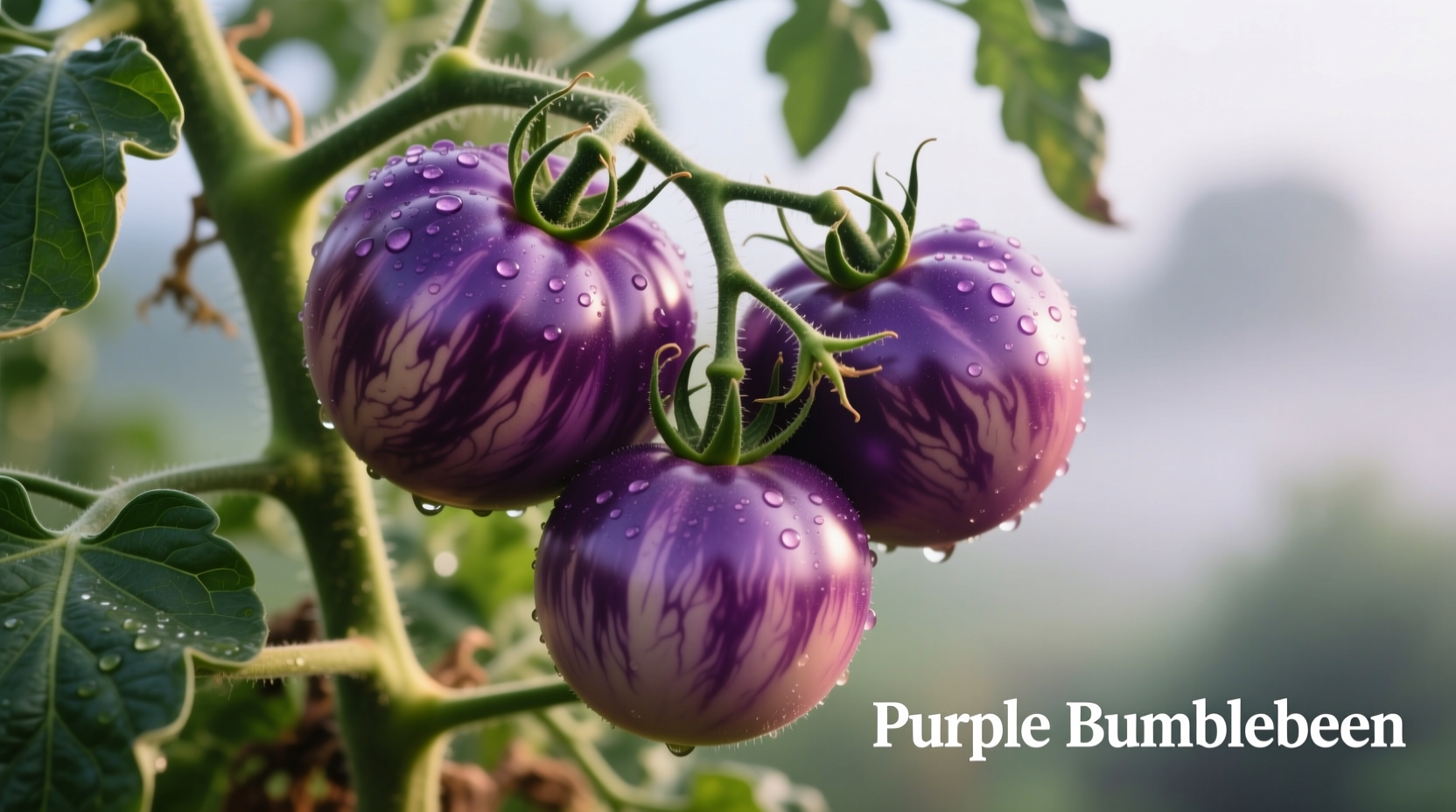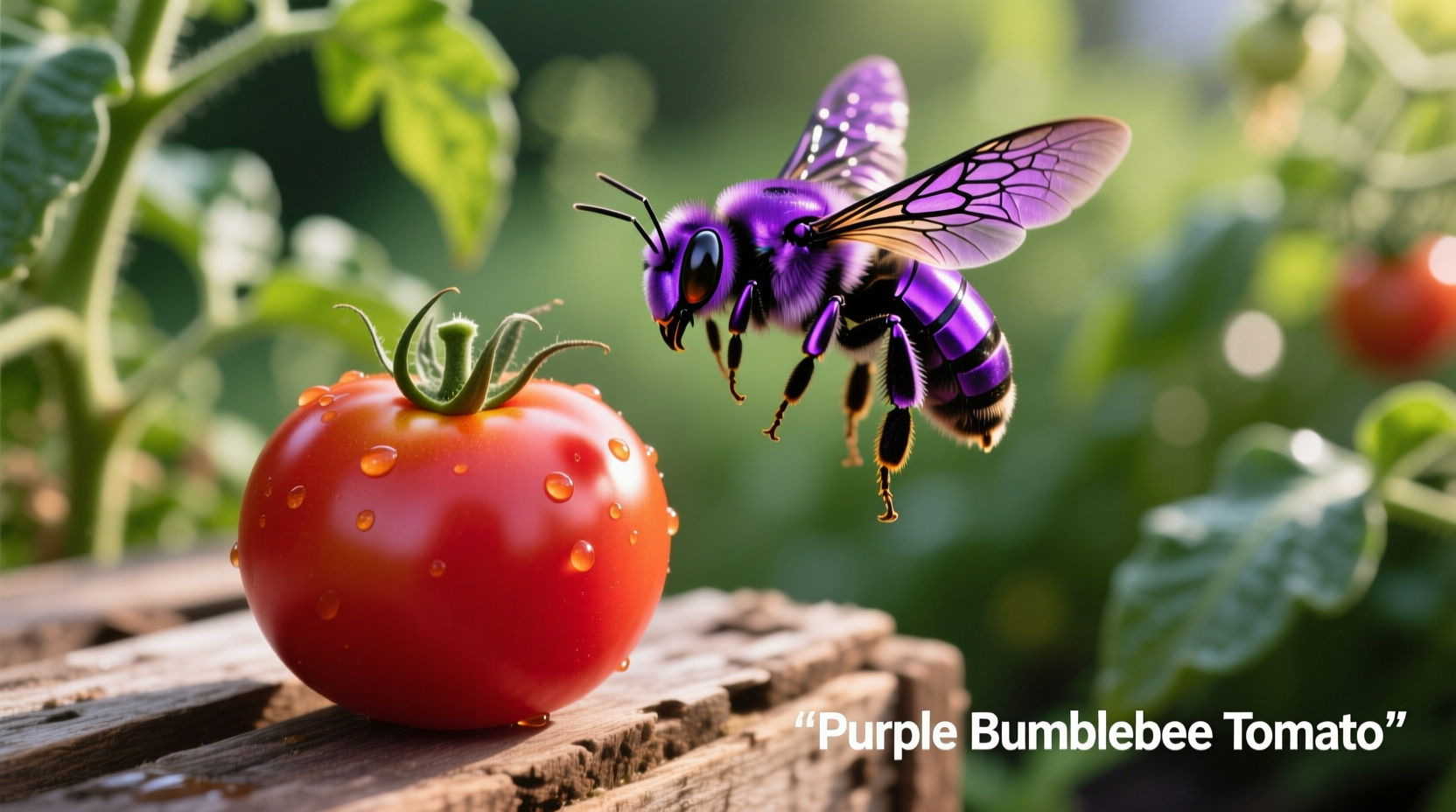Discover why gardeners across North America are falling in love with Purple Bumblebee tomatoes—the vibrant heirloom variety that combines stunning visual appeal with exceptional flavor. Whether you're a beginner gardener or seasoned tomato enthusiast, this comprehensive guide delivers everything you need to know about growing, harvesting, and using these remarkable fruits. You'll learn proven cultivation techniques, optimal harvesting windows, and creative culinary applications that make this variety worth the effort.
What Makes Purple Bumblebee Tomatoes Special
Purple Bumblebee tomatoes (Solanum lycopersicum) stand out in any garden with their distinctive coloration and rich flavor profile. Unlike standard red varieties, these tomatoes develop deep purple shoulders that gradually ripen to a reddish-purple hue when mature. The striking color comes from anthocyanins—powerful antioxidants also found in blueberries and blackberries.
Developed through careful selective breeding, Purple Bumblebee tomatoes represent a modern heirloom variety that combines the best traits of traditional purple tomatoes with improved disease resistance and yield. Their complex flavor balances sweetness with earthy undertones and a hint of smokiness, making them versatile for both fresh eating and cooking.
| Characteristic | Purple Bumblebee | Standard Red Tomato |
|---|---|---|
| Days to Maturity | 70-80 days | 60-75 days |
| Fruit Weight | 6-8 oz (170-225g) | 4-6 oz (115-170g) |
| Plant Type | Indeterminate | Varies |
| Anthocyanin Content | High | Low |
| Flavor Profile | Sweet with earthy notes | Balanced sweet-tart |
Complete Growing Guide for Success
Understanding the specific needs of Purple Bumblebee tomatoes ensures healthy plants and abundant harvests. These indeterminate varieties continue growing and producing fruit throughout the season until frost, requiring proper support and maintenance.
Starting Seeds Indoors
Begin Purple Bumblebee seeds indoors 6-8 weeks before your last expected frost date. Maintain soil temperature between 70-80°F (21-27°C) for optimal germination, which typically occurs within 5-10 days. Use a quality seed starting mix and provide 14-16 hours of light daily to prevent leggy growth.
Transplanting to Your Garden
Transplant seedlings outdoors when soil temperatures consistently reach 60°F (15°C) and nighttime temperatures stay above 50°F (10°C). Space plants 24-36 inches apart in rows 4-5 feet apart. Purple Bumblebee tomatoes benefit from deep planting—bury the stem up to the first set of true leaves to encourage stronger root development.
Essential Care Requirements
- Sunlight: Minimum 6-8 hours of direct sun daily
- Soil: Well-draining loam with pH 6.2-6.8
- Watering: Consistent moisture (1-2 inches weekly), avoid overhead watering
- Fertilizing: Balanced organic fertilizer at planting, then monthly applications
- Support: Sturdy cages or trellises for indeterminate growth habit
Harvesting at Peak Flavor
Timing your harvest correctly maximizes the exceptional flavor of Purple Bumblebee tomatoes. Unlike red varieties that show obvious color changes, these tomatoes require careful observation to determine ripeness.
Look for these ripeness indicators:
- Fruit develops full purple-black shoulders with reddish undertones
- Slight softening when gently squeezed
- Characteristic sweet, earthy aroma
- Fruit easily separates from the stem with a gentle twist
Harvest in the morning when sugars are most concentrated. Purple Bumblebee tomatoes typically reach maturity 70-80 days after transplanting, with continuous production throughout the growing season.

Culinary Applications and Flavor Pairings
Purple Bumblebee tomatoes shine in both raw and cooked applications thanks to their complex flavor profile. Their dense flesh holds up well to cooking while maintaining excellent fresh-eating qualities.
Best Culinary Uses
- Caprese salad: The deep color creates stunning visual contrast with mozzarella
- Sauces and salsas: Rich flavor deepens cooked preparations
- Roasted dishes: Concentrates sweetness while maintaining structure
- Tomato tartare: Showcases the beautiful color in raw preparations
Pair Purple Bumblebee tomatoes with complementary flavors like fresh basil, balsamic vinegar, garlic, and mild cheeses. Their earthy notes work particularly well with ingredients like mushrooms and roasted peppers.
Common Challenges and Solutions
While Purple Bumblebee tomatoes are relatively resilient, they face some common challenges that gardeners should anticipate.
Purple Shoulder Disorder
This condition causes uneven ripening with persistent purple shoulders. Prevent it by ensuring consistent watering and adequate potassium levels in the soil. According to research from the University of Minnesota Extension, maintaining proper nutrient balance significantly reduces this issue.
Disease Management
Though Purple Bumblebee tomatoes show good resistance to common tomato diseases, they remain susceptible to:
- Early blight (Alternaria solani)
- Septoria leaf spot
- Fusarium wilt
Prevent disease through crop rotation, proper spacing for air circulation, and mulching to prevent soil splash. The USDA Agricultural Research Service recommends removing affected leaves promptly to prevent spread.
How Purple Bumblebee Compares to Other Purple Varieties
Understanding how Purple Bumblebee differs from similar varieties helps gardeners select the best option for their needs.
| Variety | Size | Flavor Profile | Days to Maturity | Special Characteristics |
|---|---|---|---|---|
| Purple Bumblebee | 6-8 oz | Sweet with earthy notes | 70-80 | High anthocyanin, indeterminate |
| Cherokee Purple | 8-12 oz | Rich, complex, smoky | 75-85 | Larger fruit, heirloom |
| Indigo Rose | 2-4 oz | Mild, balanced | 65-75 | Determinate, smaller fruit |
| Black Beauty | 8-10 oz | Earthy, rich | 80-90 | Late season, Russian heirloom |
Purple Bumblebee offers a middle ground between the larger Cherokee Purple and smaller Indigo Rose varieties, with excellent disease resistance and consistent production throughout the season.
Preserving Your Harvest
With abundant production, preserving Purple Bumblebee tomatoes extends their enjoyment beyond the growing season. Their high anthocyanin content makes them particularly suitable for certain preservation methods.
- Canning: Maintain vibrant color when processed with proper acidity
- Drying: Concentrates flavor while preserving nutritional benefits
- Freezing: Best for sauce-making rather than fresh applications
- Tomato powder: Creates versatile seasoning with intense flavor
When preserving, maintain the distinctive purple color by avoiding overprocessing and using proper pH levels. The National Center for Home Food Preservation provides science-based guidelines for safe tomato preservation.











 浙公网安备
33010002000092号
浙公网安备
33010002000092号 浙B2-20120091-4
浙B2-20120091-4